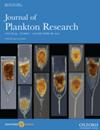亚北极太平洋中上层片脚类动物群落的昼夜、季节和垂直变化:来自成像分析的见解
IF 2
3区 环境科学与生态学
Q2 MARINE & FRESHWATER BIOLOGY
引用次数: 0
摘要
在亚北极太平洋西部的一个站点,在四个季节从深度达1000米的垂直分层白天和夜间样本收集。利用ZooScan软件对中上层片脚类动物的丰度、生物量、群落结构和种群结构进行了分析。测定了各树种的稳定同位素比值(δ15N)。共鉴定出10种片足类,其群落结构可划分为4个类群。4个群落表现为上层群落以海苔为主,深水群落以海苔缺失为特征。另外两组仅在夜间观察到中间深度,其特征是太平洋T. pacific的丰度较低,从这些深度进行昼夜垂直迁移。深栖物种δ15N值较高,且与生境深度呈正相关。对于优势种太平洋野鼠,种群结构(队列)分析基于ZooScan的等效球径数据。本研究表明,ZooScan的成像分析适用于浮游动物群落中较小的分类类群(片脚类)的分析。本文章由计算机程序翻译,如有差异,请以英文原文为准。
Diel, seasonal and vertical changes in the pelagic amphipod communities in the subarctic Pacific: insights from imaging analysis
Vertically stratified day and night samples were collected from a depth of up to 1000 m during four seasons at a single station in the western subarctic Pacific. Subsequently, the abundance, biovolume, community structure and population structure of the pelagic amphipods were evaluated from the imaging analysis using ZooScan. The stable isotope ratio (δ15N) was also measured for each species. In total 10 amphipod species were identified in total, and their community structures were separated into four groups. The four communities were characterized by the upper-layer community dominated by Themisto pacifica, and the deep-water community that was characterized by the absence of T. pacifica. The other two groups were observed for the intermediate depths at night only, which was characterized by the low abundance of T. pacifica performing diel vertical migration from those depths. The deep-dwelling species displayed higher δ15N and positive relationships were detected with the habitat depth of each species. For the predominant T. pacifica, population structure (cohort) analysis was possible based on equivalent spherical diameter data from ZooScan. This study demonstrates that imaging analysis by ZooScan is applicable for analyses of minor taxonomic groups (amphipods) in zooplankton communities.
求助全文
通过发布文献求助,成功后即可免费获取论文全文。
去求助
来源期刊

Journal of Plankton Research
生物-海洋学
CiteScore
3.50
自引率
9.50%
发文量
65
审稿时长
1 months
期刊介绍:
Journal of Plankton Research publishes innovative papers that significantly advance the field of plankton research, and in particular, our understanding of plankton dynamics.
 求助内容:
求助内容: 应助结果提醒方式:
应助结果提醒方式:


